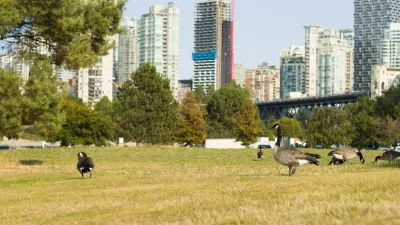A wide-ranging research study highlights the various qualities that make animal species living in urban environments thrive—and how biodiversity improves the health of our cities.

New research from the University of Melbourne identifies four distinct sets of traits that help urban wildlife adapt and survive in environments that seem hostile to animals. Writing in Wired, Maria Paula Escobar-Tello describes the findings. “The researchers looked at four animal characteristics—diet, body size, mobility, and reproductive strategy—that can vary according to what a city has to offer and how flexible a species can be.”
The study, which compiled data from 379 global cities, found that animal species fell into different categories. Some, the “mobile generalists,” do keep their options for diet and resting places open and move around frequently as needed. Others, termed “central place foragers,” nest and sleep in the same place, but forage for food over a broad range.
Then there are the “site specialists,” the study adds. “Reptiles and amphibians adopt a different strategy again: Faced with scarcer food, higher vulnerability to predators, road accidents, and pollution, they respond to urbanization by specializing their diets, moving around smaller areas, and reducing the size of their clutches.”
Why is biodiversity important for cities at all? “Greater biodiversity provides knock-on benefits, what are known as ‘ecosystem services,’” the article explains. A greater diversity of species can maintain healthier ecosystems, from microorganisms that clean the soil to local wildlife that keep disease-spreading pests like mosquitoes in check. “If you look at the traits animals are adopting to survive in urban environments, you can see how cities could be modified to become more habitable to a wider variety of species.”
FULL STORY: Why Some Animals Thrive in Cities

Planetizen Federal Action Tracker
A weekly monitor of how Trump’s orders and actions are impacting planners and planning in America.

Congressman Proposes Bill to Rename DC Metro “Trump Train”
The Make Autorail Great Again Act would withhold federal funding to the system until the Washington Metropolitan Area Transit Authority (WMATA), rebrands as the Washington Metropolitan Authority for Greater Access (WMAGA).

The Simple Legislative Tool Transforming Vacant Downtowns
In California, Michigan and Georgia, an easy win is bringing dollars — and delight — back to city centers.

Commentary: Our Silence Will Not Protect Us
Keeping our heads down and our language inoffensive is not the right response to the times we’re in. Solidarity and courage is.

Good Cause Eviction Policies Don’t Hamper Construction, New Research Shows. Legislators Are Still Concerned.
Multiple states have ongoing pushes for good cause eviction protections. A frequent obstacle: a now disproven claim by developers.

Demise of Entertainment Industry Mirrors Demise of Housing in LA
Making movies has a lot in common with developing real estate: producers = developers; screenwriters = architects; directors = general contractors. The similarities are more than trivial. Both industries are now hurting in L.A.
Urban Design for Planners 1: Software Tools
This six-course series explores essential urban design concepts using open source software and equips planners with the tools they need to participate fully in the urban design process.
Planning for Universal Design
Learn the tools for implementing Universal Design in planning regulations.
Smith Gee Studio
City of Charlotte
City of Camden Redevelopment Agency
City of Astoria
Transportation Research & Education Center (TREC) at Portland State University
US High Speed Rail Association
City of Camden Redevelopment Agency
Municipality of Princeton (NJ)





























